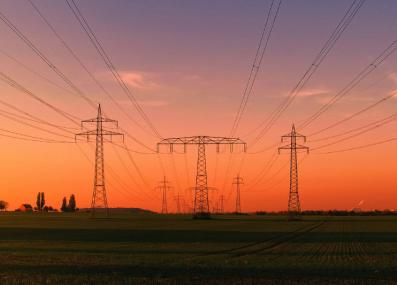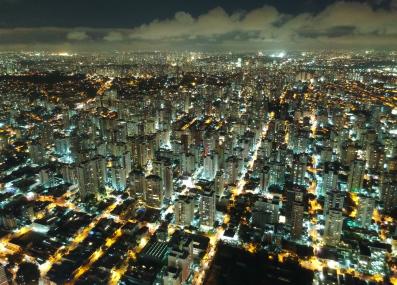New to climate change?
The Electric Grid
We use electricity every day—to turn on the lights, to charge our phones, and to keep our food cold. But most of us don’t make our own electricity. Instead, we get it from the electric grid, an interconnected network of power lines and other infrastructure that allows us to move electricity from power plants to our homes, businesses, and factories. Though it’s often generally referred to as “the electric grid,” countries can have more than one: for example, the U.S. has three quite separate electric grids that span the country.
The electric grid—and how electricity is generated—plays a crucial role in slowing and stopping climate change. Currently, almost two-thirds of our electricity around the world is generated by burning fossil fuels, a process that releases large amounts of carbon dioxide and other planet-warming greenhouse gases and is among the primary causes of climate change.1 At the same time, the grid is vulnerable to extreme weather events, like hurricanes2 and heat waves, that are becoming more common or more intense as our planet warms.
To slow down—and to protect ourselves—from climate change, energy experts say our grid must become cleaner and more adaptable.
How the grid works
In 1879, a power company in San Francisco connected a coal-fired steam engine to two generators, powering 20 lightbulbs—and creating the first electric grid.3 Innovation took off from there, from inventions as simple as switches that allow us to turn on and off appliances without shutting down the grid; as far-reaching as transcontinental “transmission lines” that move electricity over hundreds of thousands of miles4; and as complex as utilities, which are companies that make sure there’s enough electricity for all users on an electric grid.
Today, most electricity worldwide is generated in large power plants that run on fossil fuels like coal and natural gas, and, to a lesser extent, from low-carbon sources like nuclear, wind turbines, solar panels, and running water (“hydropower”).5 Electric utilities and other entities in charge of operating the grid decide when to turn on or ramp up certain kinds of power production based on expected demand. There’s a constant balance between generating enough electricity to meet demand—and prevent blackouts—while not producing too much electricity, which can lead utilities to take costly measures like disconnecting certain generators from the grid.
Cleaning up the grid
Electricity accounts for 40% of our global greenhouse gas emissions from energy.6 Curbing emissions from electricity hinges on switching to low-carbon electricity sources, such as solar, wind, hydropower, and nuclear. One key way to speed up this transition is for utilities to no longer build new power plants that run on fossil fuels. This is already happening in some parts of the world, with countries like South Korea, Indonesia, and Poland pledging to no longer allow new coal-fired power plant development.7 Another is to close fossil fuel power plants before they were scheduled to shut down; over the last ten years, U.S. power companies announced the retirement of more than 500 coal power plants.8 At the same time, utilities will need to build or buy power from new low-carbon electricity generators to keep up with growing demand.9
The grid also needs to be adapted to handle the influx of “variable” and “distributed” energy sources. Wind and solar power are “variable”— while a coal-fired power plant can burn as much coal as is stored at the plant, grid operators can’t just make the wind blow or the sun shine when they need more electricity. The variability of wind and solar makes it harder to control the flow of electricity from these sources onto the electric grid. And, as more homes and businesses install solar panels on their roofs and land and send their power back to the grid, utilities need to account for managing the flow of this “distributed” energy generation.
Researchers and utilities are looking at a number of ways to make our grid smarter—that is, better equipped to handle more low-carbon electricity while reducing costs and power outages. Upgrading the existing grid by building new transmission lines to better move power from wind farms and other renewable resources in rural areas to urban areas is one way to do this. Local distribution systems can be adapted to better handle electricity flowing onto the grid from local power generators, and to provide flexibility to the main grid. Other ways to upgrade our grid include accompanying variable power sources with large batteries to store electricity for later use and installing more sensors and smart appliances to better balance electricity production and use.
A grid for a changing climate
Climate experts say that a key way to lower greenhouse gas emissions is to power our cars and home appliances with low-carbon electricity instead of fossil fuels, what’s commonly called the “electrification of everything.” In addition, more than 750 million people in low-income countries lack access to electricity, and there is a global goal to connect them to the grid by 2030.10 These transitions would require a lot more electricity than we generate today —researchers have estimated that by 2050, total electricity generation would need to increase at least 2.5 times from today’s levels.11
As electricity provides more of our energy needs, and as climate change worsens certain kinds of storms,12 protecting the grid from power outages becomes even more important. One way to do this is to create “microgrids” by accompanying distributed generation with battery storage. This allows communities to separate from the main grid during storms and draw on stored electricity to keep the lights on even if the main grid goes down. Puerto Rico, for example, is looking at using these “microgrids” to help protect critical services like hospitals and water purification when hurricanes hit.13 Another way is to encourage “demand management,” which is to strategically shift demand for electricity over time or uses to prioritize the most critical needs. For example, people could be encouraged to use less electricity during times of high demand, like waiting to run a clothes dryer until after a summer heat wave, when air conditioning is most important; or charging electric cars at night when other electricity needs are low. Using more efficient appliances, like EnergyStar appliances, also will help people reduce the amount of electricity they consume. The combination of these micro-actions, which don’t significantly affect people’s comfort, can help avoid severe blackouts.14
Published May 24th, 2022.
1 Ritchie, Hannah, and Max Roser. “Electricity Mix.” Our World in Data, 28 Nov. 2020, https://ourworldindata.org/electricity-mix#:~:text=In%202019%2C%20almost%20two%2Dthirds,been%20pretty%20stagnant%20for%20decades.
2 Kossin, James P., et al. “Global Increase in Major Tropical Cyclone Exceedance Probability over the Past Four Decades.” Proceedings of the National Academy of Sciences, vol. 117, no. 22, 2020, pp. 11975–11980., https://doi.org/10.1073/pnas.1920849117.
3 Bakke, Gretchen Anna. The Grid: The Fraying Wires between Americans and Our Energy Future. Bloomsbury, 2017.
4 “Electricity Explained: How Electricity Is Delivered to Consumers.” U.S. Energy Information Administration, 3 Nov. 2021, https://www.eia.gov/energyexplained/electricity/delivery-to-consumers.php.
5 “Key World Energy Statistics 2021 – Transformation.” International Energy Agency , International Energy Agency, 2021, https://www.iea.org/reports/key-world-energy-tatistics-2021/transformation#electricity-generation.
6 “Greenhouse Gas Emissions from Energy: Overview .” International Energy Agency, International Energy Agency, 2021, https://www.iea.org/reports/greenhouse-gas-emissions-from-energy-overview/drivers-of-co2-emissions.
7 Plumer, Brad, and Lisa Friedman. “Over 40 Countries Pledge at U.N. Climate Summit to End Use of Coal Power.” New York Times, 4 Nov. 2021, https://www.nytimes.com/2021/11/04/climate/cop26-coal-climate.html.
8 “More U.S. Coal-Fired Power Plants Are Decommissioning as Retirements Continue.” Today in Energy, U.S. Energy Information Administration (EIA), 26 July 2019, https://www.eia.gov/todayinenergy/detail.php?id=40212.
9 Reuters. “Emissions Set to Rise with Global Power Demand - IEA.” Reuters, 14 Jan. 2022, https://www.reuters.com/business/energy/emissions-set-rise-with-global-power-demand-iea-2022-01-14/#:~:text=Global%20electricity%20demand%20rose%20by,report%20on%20the%20electricity%20sector.
10 United Nations Statistics Division. “Ensure Access to Affordable, Reliable, Sustainable and Modern Energy for All.” United Nations, United Nations, 2021, https://unstats.un.org/sdgs/report/2021/goal-07/.
11 International Energy Agency , 2021, Net Zero by 2050 - A Roadmap for the Global Energy Sector - Summary for Policymakers, https://iea.blob.core.windows.net/assets/7ebafc81-74ed-412b-9c60-5cc32c8396e4/NetZeroby2050-ARoadmapfortheGlobalEnergySector-SummaryforPolicyMakers_CORR.pdf. Accessed 18 Apr. 2022.
12 Intergovernmental Panel on Climate Change, Working Group I, 2021, Climate Change 2021: The Physical Science Basis Summary for Policymakers, https://www.ipcc.ch/report/ar6/wg1/downloads/report/IPCC_AR6_WGI_SPM_final.pdf.
13 Jeffers, Robert Frederic, et al. 2018, Analysis of Microgrid Locations Benefitting Community Resilience for Puerto Rico, https://www.osti.gov/biblio/1530167.
14 Menati, Ali, and Le Xie. “A Preliminary Study on the Role of Energy Storage and Load Rationing in Mitigating the Impact of the 2021 Texas Power Outage.” 2021 North American Power Symposium (NAPS), 2021, https://doi.org/10.1109/naps52732.2021.9654452.








